Cancer Biologics Market | Growth, Trends, and Forecast 2025-2035
Explore the comprehensive forecast for the Cancer Biologics Market from 2025 to 2035. Understand key growth drivers, emerging trends, market dynamics, segmentation, and competitive landscape shaping the future of cancer treatments.
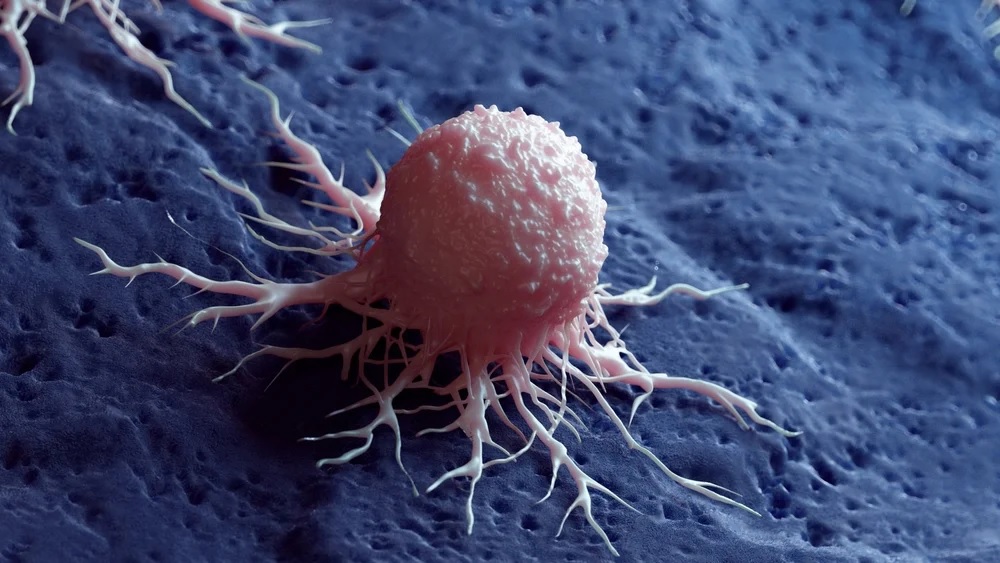
Cancer Biologics Market Industry 2025-2035: An In-depth Market Research Report
The Cancer Biologics Market is one of the fastest-growing segments within the global pharmaceutical industry. With the increasing incidence of cancer worldwide and advancements in biotechnology, the market is expected to experience substantial growth between 2025 and 2035. Cancer biologics represent a class of drugs derived from living organisms that are designed to target and treat cancer cells more precisely compared to traditional chemotherapy. These biologics, which include monoclonal antibodies, cancer growth inhibitors, gene therapies, and vaccines, among others, have revolutionized the way cancer is treated.
The significance of the cancer biologics market lies in its potential to improve patient outcomes, offering targeted therapies that minimize the harsh side effects typically associated with conventional cancer treatments. The key findings of this report indicate an accelerating trend in the development of biologics and an increased focus on personalized treatments. As the understanding of cancer genetics deepens and technologies such as CAR-T therapy and gene editing evolve, the biologics market is poised for transformative growth.
The report will cover various facets of the cancer biologics market, including its market dynamics, key growth drivers, and emerging trends, as well as an analysis of the segments within the industry. Additionally, it will examine the competitive landscape, highlight important players, and explore the future outlook of the market.
Download Sample Report PDF (Including Full TOC, Table & Figures) @ https://www.vantagemarketresearch.com/cancer-biologics-market-2506/request-sample
Highlights:
- Market Segmentation: The market is categorized into various drug classes, including monoclonal antibodies, cancer growth inhibitors, vaccines, and CAR-T cells, among others.
- Key Drivers: Factors such as technological advancements, rising healthcare expenditures, and a growing focus on targeted therapies are driving market growth.
- Industry Trends: The shift toward personalized medicine and the integration of artificial intelligence in drug development are notable trends.
- Competitive Landscape: Major players are focusing on strategic collaborations and mergers to enhance their market presence.
Cancer Biologics Market Size and Forecast
The cancer biologics market is characterized by its rapid growth, driven by the increasing prevalence of cancer, advancements in biotechnology, and rising global healthcare investments. In 2024, the market was valued at an estimated USD 106.2 billion, and it is projected to expand significantly in the coming years, reaching a value of upwards of USD 161.4 billion by 2035. This robust growth is underpinned by continuous innovation in biologic treatments, such as monoclonal antibodies, CAR-T cells, and immune checkpoint inhibitors, which have demonstrated high efficacy in treating various types of cancer.
A major highlight of this market is the diversification of treatment options. With numerous drug classes, including monoclonal antibodies, gene therapies, and cancer vaccines, the biologics market is becoming increasingly specialized, offering more targeted treatments that focus on the individual needs of patients. This has led to the increasing adoption of precision medicine, where treatments are tailored to the genetic makeup of both the patient and the tumor. The market is segmented by drug class, application, end-use, and region, with each segment contributing to the overall market's growth and dynamics.
Additionally, the rise of immunotherapy, with its promising results in treating previously untreatable cancers, has further bolstered the market. Companies are investing heavily in the research and development of biologic therapies that can enhance immune system response, leading to more effective and durable cancer treatments.
Key Takeaways from the Cancer Biologics Market Report
- The market is expected to witness robust growth driven by the increasing demand for effective cancer treatments.
- Personalized medicine is becoming a focal point, with a growing emphasis on tailored therapies based on genetic profiling.
Take Action Now: Secure Your Position in the Global Cancer Biologics Industry Today – Purchase Now.
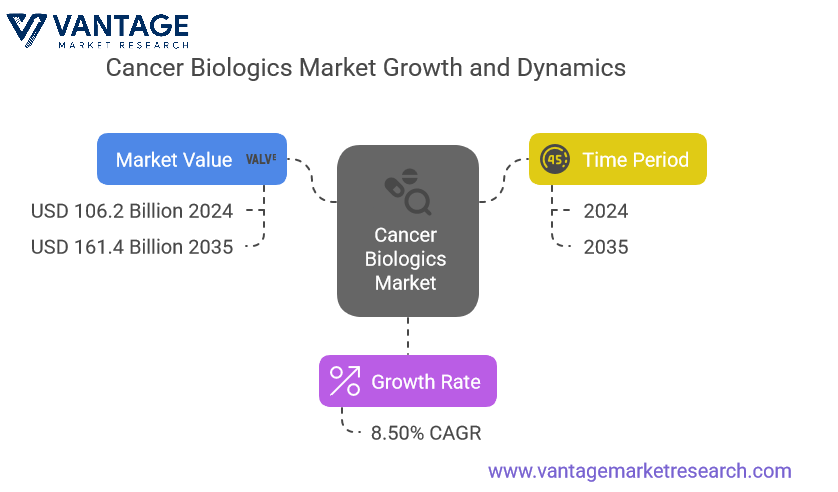
Market Dynamics
Growth Drivers
- Rising Cancer Incidence: The increasing prevalence of various cancers globally is a primary driver for the market.
- Technological Advancements: Innovations in biotechnology and drug development are enhancing the efficacy of treatments.
Several key drivers are fueling the growth of the cancer biologics market. First and foremost is the increasing global cancer incidence. According to the World Health Organization, cancer is one of the leading causes of death worldwide, with over 9.6 million deaths reported in 2018. This alarming statistic underscores the urgent need for more effective cancer treatments, particularly those that are tailored to specific cancer types.
Another significant driver is the ongoing advancement in biotechnology and genetic research. The development of monoclonal antibodies, CAR-T cells, and other biologics has revolutionized cancer treatment, providing more targeted therapies that improve patient survival rates and reduce side effects.
Moreover, the growing demand for personalized medicine is accelerating the adoption of cancer biologics. With the understanding that each patient’s genetic makeup affects how they respond to treatment, biologics are increasingly seen as the cornerstone of precision medicine, offering treatments that are better suited to the individual.
Market Restraints & Challenges
- High Costs: The high cost of biologic therapies can limit accessibility for patients.
- Regulatory Hurdles: Stringent regulations and lengthy approval processes can impede market entry for new products.
Despite the promising prospects of the cancer biologics market, several challenges persist. One of the primary challenges is the high cost of biologic therapies. The production of biologic drugs is complex and expensive, resulting in high prices for the end consumer. This makes biologics less accessible, particularly in low- and middle-income countries.
Additionally, the potential for adverse effects and long-term complications associated with some biologic treatments remains a concern. Although these treatments are generally more targeted than traditional chemotherapy, they can still cause serious side effects, including immune system reactions and organ damage.
Regulatory hurdles also pose challenges, as new biologic treatments must undergo rigorous clinical trials and approval processes, which can delay market entry. Furthermore, there is the ongoing issue of intellectual property protection and biosimilars, which can undermine the exclusivity of branded biologic drugs once patents expire.
Growth Opportunities & Emerging Trends
- Immunotherapy: The growing focus on immunotherapy presents significant opportunities for growth.
- Emerging Markets: The expansion of healthcare infrastructure in developing regions is expected to drive market growth.
The cancer biologics market presents numerous growth opportunities, particularly in the field of immuno-oncology. Immune checkpoint inhibitors, such as pembrolizumab and nivolumab, are showing immense promise in treating cancers that have been difficult to target with traditional therapies. There is also significant interest in CAR-T cell therapies, which involve engineering a patient’s immune cells to attack cancer cells. This treatment modality is particularly effective for blood cancers and has the potential to transform the treatment landscape for other types of cancer.
Additionally, the rise of gene therapies and CRISPR-based technologies opens new avenues for precision treatments that target the genetic drivers of cancer. As these technologies mature, they are expected to become integral parts of the biologics market.
Regional Breakdown
- North America dominates the market due to its advanced healthcare systems and high R&D investments.
- Europe: Shows significant growth potential driven by increasing awareness and healthcare reforms.
- Asia Pacific: Rapidly emerging as a key market due to the increasing incidence of cancer cases and improved access to healthcare.
North America dominates the cancer biologics market, driven by a strong healthcare infrastructure, substantial investments in research and development, and the presence of leading biotech and pharmaceutical companies. The United States is home to several of the world’s largest biopharmaceutical companies, including Amgen, Genentech, and Bristol-Myers Squibb, all of which have made significant contributions to the development of cancer biologics.
Europe follows closely behind, with significant advancements in biologics research and development occurring in countries such as Germany, the UK, and Switzerland. The Asia Pacific region is also expected to experience rapid growth, primarily driven by increasing healthcare spending, enhanced healthcare infrastructure, and a rising cancer burden.
For the Cancer Biologics Market Research Report and updates, view the full report now!
Segments Insights
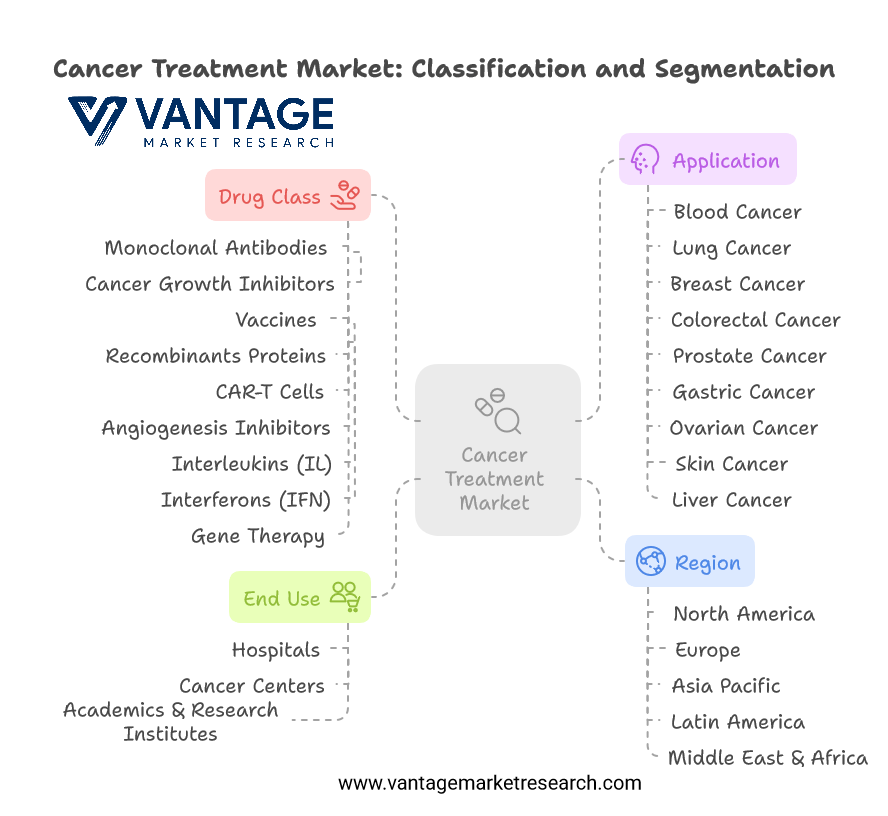
By Drug Class
- Monoclonal Antibodies: Leading segment due to their targeted action against cancer cells.
- CAR-T Cells: Gaining traction for their effectiveness in treating hematological malignancies.
- Vaccines: Emerging as a preventive measure against certain types of cancer.
The cancer biologics market is segmented into several drug classes, each serving a unique role in cancer treatment. Monoclonal antibodies dominate the market, with drugs such as rituximab and trastuzumab demonstrating remarkable efficacy in treating cancers like lymphoma and breast cancer. Cancer growth inhibitors, vaccines, and recombinant proteins also play vital roles in managing cancer, either by blocking the pathways that drive tumor growth or by enhancing the immune system’s ability to fight cancer.
CAR-T cells are an emerging class of biologics, especially effective in hematologic cancers, offering curative potential for patients who have exhausted other treatment options. Other biologic classes, such as angiogenesis inhibitors and interferons, are also used in various cancer treatments.
By Application
- Blood Cancer: Maintains a significant market share due to its high incidence rates.
- Lung Cancer: A major focus area for research and development.
- Breast Cancer: Continues to be a leading area of application for biologics.
Cancer biologics are employed across multiple cancer types, including blood cancer, lung cancer, breast cancer, colorectal cancer, and others. The market sees significant use in blood cancers, where CAR-T cells and monoclonal antibodies are particularly effective. Lung and breast cancers are also major applications, with biologics playing a critical role in targeted therapies that have substantially improved survival rates.
By End Use
- Hospitals: Major consumers of cancer biologics due to treatment protocols.
- Cancer Centers: Specialized facilities driving demand for advanced therapies.
- Academics & Research Institutes: Contributing to innovation and development of new treatments.
Hospitals and cancer centers are the primary end-users of cancer biologics, where these therapies are administered in clinical settings. Academic and research institutes also play a significant role in advancing the development of new biologic therapies, making substantial contributions to the overall market growth.
By Region
- North America: The Largest market share, driven by technological advancements and high healthcare spending.
- Europe: Strong growth is driven by supportive regulatory frameworks.
- Asia Pacific: Rapid growth anticipated due to increasing healthcare investments.
North America remains the largest market for cancer biologics, but growth is also accelerating in the Asia Pacific region, which is becoming an increasingly important hub for biopharma innovation. The Middle East and Africa are expected to experience moderate growth, driven by improvements in healthcare systems and increasing investments in cancer treatment infrastructure.
Competitive Landscape
The competitive landscape of the Cancer Biologics Market features key players such as:
- Abbott Laboratories (U.S.)
- Angel Pharmaceuticals (China)
- Amgen Inc. (U.S.)
- AstraZeneca (UK)
- BioNTech (Germany)
- Bristol-Mayer Squibb Company (U.S.)
- Dr. Reddy's Laboratories (India)
- Duality Biologics (China)
- Eli Lilly and Company (U.S.)
- F. Hoffmann-La Roche Ltd. (Switzerland)
Strategic partnerships, mergers, and acquisitions are prevalent in this market as companies strive to enhance their capabilities in biologics. Companies are also focusing on the development of next-generation therapies, such as CAR-T cells and immune checkpoint inhibitors, which are expected to play a central role in the future of cancer treatment.
The cancer biologics market is highly competitive, with numerous global and regional players vying for dominance. Key players include Abbott Laboratories, Amgen, AstraZeneca, BioNTech, Bristol-Myers Squibb, Roche, and Eli Lilly, among others. These companies are heavily invested in R&D and continually seek to expand their portfolios of cancer biologic treatments. These companies are focusing on strategic partnerships, mergers, and acquisitions to enhance their product portfolios and market reach.
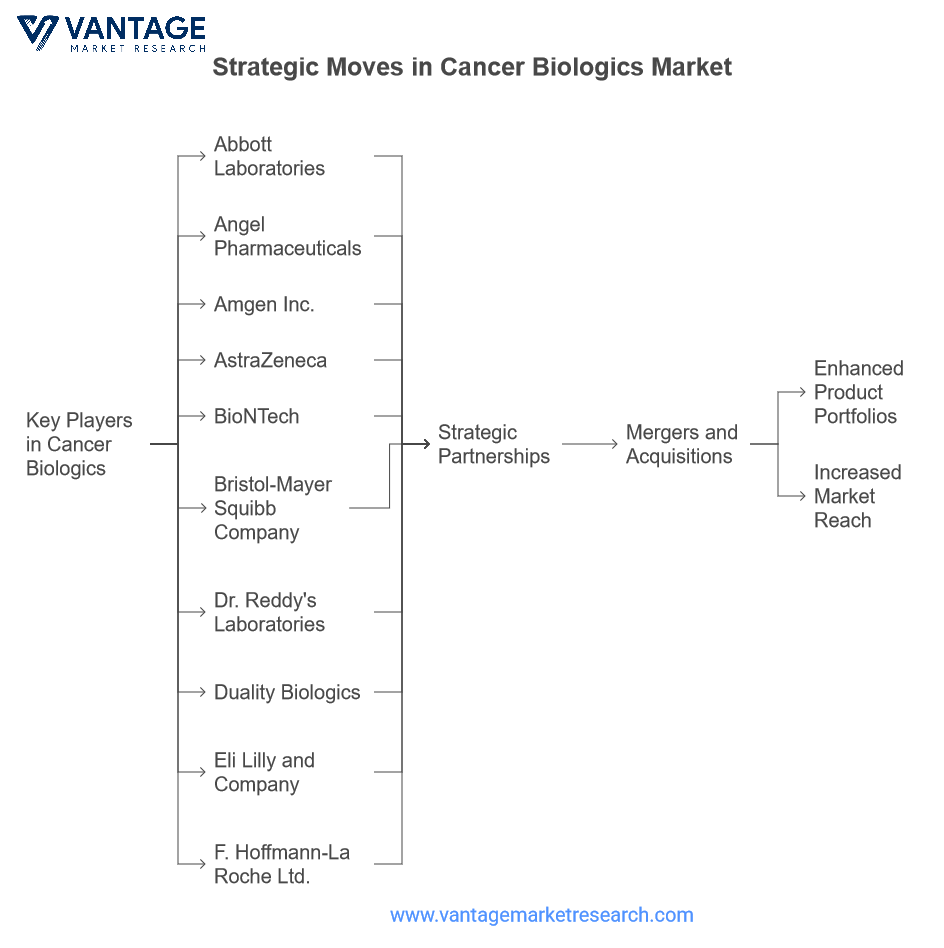
Report Coverage
According to analysts at Vantage Market Research, the global Cancer Biologics Market is valued at USD 106.2 billion in 2024 and is projected to reach a value of USD 161.4 billion by 2035, growing at a CAGR of 8.50% between 2025 and 2035. This report provides a comprehensive analysis of the cancer biologics market, encompassing market dynamics, segmentation, regional analysis, and a competitive landscape. It highlights key growth drivers, opportunities, challenges, and trends while also offering a thorough examination of the market segments by drug class, application, end-use, and region.
Conclusion and Future Outlook
The future of the cancer biologics market looks incredibly promising. As cancer continues to be one of the leading causes of death globally, the demand for effective, targeted, and personalized treatments is only expected to increase. The market is expected to continue experiencing significant growth, driven by advancements in biotechnology, immunotherapy, and gene-editing technologies.
Despite challenges such as high costs and regulatory hurdles, the market offers vast opportunities for innovation and expansion. The growing focus on precision medicine and the continuous development of new biologic therapies will drive the market forward, ensuring that the future of cancer treatment is increasingly focused on individualized, effective, and less invasive options.
By 2035, cancer biologics are expected to be at the forefront of oncology treatments, offering a broad range of therapies that significantly improve patient outcomes. The market’s competitive landscape will likely shift with the introduction of novel therapies and biosimilars, ensuring that rapid advancements in cancer treatment will mark the next decade.
FAQ.
- What are the key growth drivers of the Cancer Biologics Market?
- This question examines the factors driving the growth of the cancer biologics market, including rising cancer prevalence, advancements in biotechnology, and the emergence of personalized medicine.
- What are the different drug classes within the Cancer Biologics Market?
- A question focused on understanding the various biologic drug classes used in cancer treatment, such as monoclonal antibodies, CAR-T cells, cancer vaccines, and gene therapies.
- How do cancer biologics differ from traditional chemotherapy?
- A common inquiry into the benefits and differences between biologic therapies and conventional chemotherapy treatments, particularly in terms of effectiveness, side effects, and their ability to target cancer cells.
- Which cancer types are most commonly treated with biologics?
- This question investigates which types of cancers (e.g., blood cancers, breast cancer, lung cancer) benefit the most from biologic treatments.
- What are the emerging trends in Cancer Biologics treatment?
- A look at the latest innovations in cancer biologics, including the development of CAR-T cell therapies, immune checkpoint inhibitors, and gene therapies.
- How are gene therapies transforming cancer biologics?
- This question explores how gene editing and gene therapies are transforming the biologics landscape, providing more personalized and effective cancer treatments.
- What challenges does the Cancer Biologics Market face?
- Common challenges include high treatment costs, regulatory hurdles, and the potential for adverse effects, which may restrict the widespread use of biologic therapies.
- What role does immunotherapy play in Cancer Biologics?
- This question focuses on the growing role of immunotherapy in cancer treatment and its integration into the biologics market for improved outcomes.
- Which companies are leading the Cancer Biologics Market?
- Key players in the cancer biologics space, including Amgen, Bristol-Myers Squibb, Roche, and Eli Lilly, and their roles in shaping the market.
- What is the future outlook for the Cancer Biologics Market?
- A question about the long-term projections for the market, discussing anticipated growth, upcoming innovations, and the potential for new biologics in treating cancer over the next decade.




![Reproductive Hormones and Proteins Tests Market Trends, Size & Forecast [2024–2035]](https://www.marketbusinessinsights.com/uploads/images/202504/image_430x256_67f61aa3326da.webp)

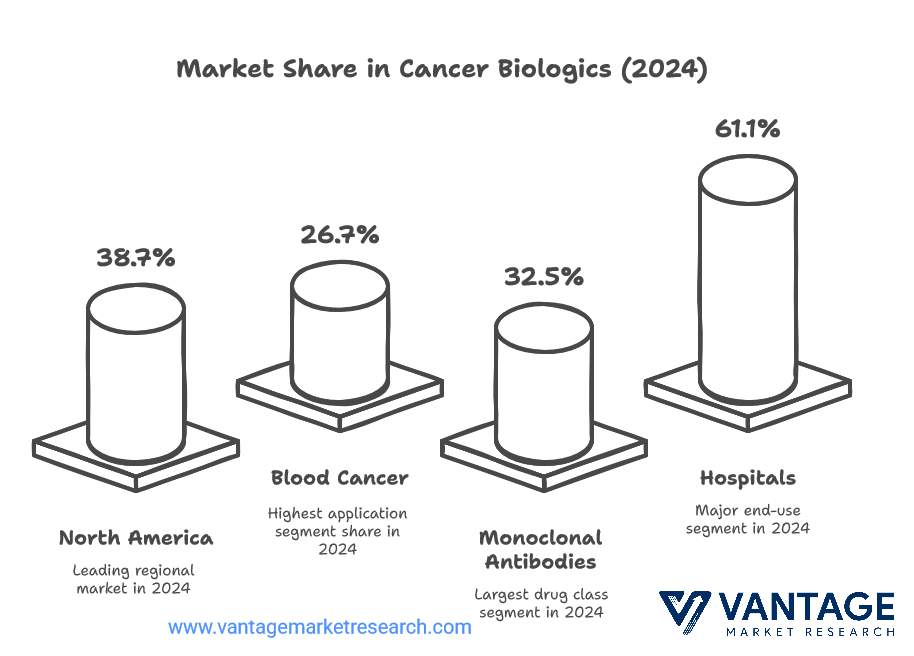






![Dialysis Market Size, Share, Trends | Growth Analysis [2035]](https://www.marketbusinessinsights.com/uploads/images/202502/image_140x98_67b34ae16c42c.webp)





![Reproductive Hormones and Proteins Tests Market Trends, Size & Forecast [2024–2035]](https://www.marketbusinessinsights.com/uploads/images/202504/image_140x98_67f61aa350968.webp)